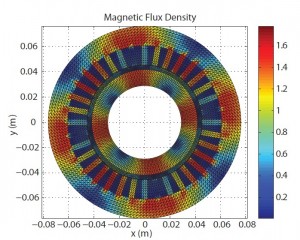Accelerating Electric Machine Analysis with Parallel Processing
Christine Ross with adviser P. T. Krein

Figure 28: MATLAB solution of the magnetic flux density for a two-dimensional, finite element simulation including the modeling of nonlinear magnetic material of the cross sectional area of an induction machine.
Industry and government need more powerful and efficient electric machines. To design them, engineers must improve their computer simulation design tools to allow simulations to be run in real time or faster. Present electric machine simulation methods involving numerical field analysis are computationally intensive, especially when a high degree of simulation accuracy is desired. A standard desktop CPU does not have the computational ability to conduct real-time electric machine simulations. And, based on the current rate of CPU development, it will be decades before real-time simulation is a practical option for desktop computers.
Fortunately, the desktop environment has another computational tool available. Graphic-processing units (GPUs) offer massive parallel computational power. Modern GPUs incorporate hundreds of processing cores and large banks of high bandwidth memory almost equivalent in size to the actual system memory. Computer unified device architecture (CUDA) is NVIDIA’s version of a C-based language for accessing the GPU’s computational abilities, and it is supported on laptops, desktops, and workstations. MATLAB MEX files provide the ability to connect MATLAB code to a GPU kernel written using CUDA. These files allow a MATLAB program to use the computational power of GPUs.
The goal is to explore the acceleration potential of electric machine numerical field analysis by incorporating GPUs. Currently, a MATLAB finite element (FE) analysis simulation of an induction machine is being developed with the intent to port the computationally intensive aspects of the program to CUDA-based routines. This research is focused on a three-dimensional, FE induction machine simulation including modeling nonlinear magnetic material. Figure 28 shows the magnetic flux density solution for a two-dimensional, MATLAB FE simulation including modeling nonlinear magnetic material of an induction machine cross-section.
This research is funded by the Grainger Center for Electric Machinery and Electromechanics.